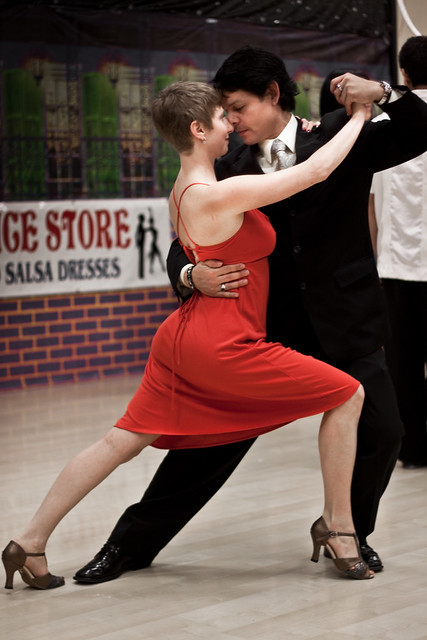 |
| Photo by aka_serge |
The story of Tango is said to have started with the gauchos of Argentina. These were men that were hardened from working with horses and also from the sweat on the horse's body. This is also why gauchos walked with flexed knees. These men would go into the crowded nightclubs and ask the local girls to dance. Since the gaucho hadn't showered, the lady would dance in the crook of the man's right arm, holding her head back. Her right hand was held low on his left hip, close to his pocket, looking for a payment for dancing with him. The man danced in a curving fashion because the floor was small with round tables, so he had to dance in between and around them.
The word "tango" is said to come from one of two sources. One of the more popular rumors in recent years has been that it came from the Niger-Congo languages of Africa. Another story is that the word "tango", which was already in common use in Andalusia to describe a style of music, lent its name to a vastly different style of music in Argentina and Uruguay.
Strangely enough, it is said that the Tango's History actually evolves from African slavery and musically used African Rhythms in the beginning. It is an intense and erotic dance and many believe that it started off in the Ghettos of Buenos Aires as far back as the 1890's with the lower classes. Back then it was known as "Baile con corte" which means "Dance with a rest." After that, it was mainly danced in Argentina, Haiti, and Cuba. It was also danced in Spain in a different form.
Between 1907 and 1912 the Tango was first introduced in France and the dance took Paris by storm. By the year 1912, it had crossed over the Channel to England.
By 1913, New York was hit by the Tango craze. What was previously a dance for the lower and middle classes was fast becoming a favorite with the upper classes.
Between 1903 and 1910 over a third of the gramophone records released were Tango music and the sheet music was sold in vast quantities all over Europe.
During the great depression of 1929, the Tango's popularity declined but it became fashionable again during the presidency of Juan Peron.
During the 1950's the Tango started it's decline again due to the economic recession and the banning of public gatherings.
During the 1980's it was revived again with the Broadway Musicals Forever Tango, Tango Passion, and Tango Argentino.
There are now three types of Tango, namely Argentine, International Style and American, and I don't think that the Tango will ever totally lose its appeal.
Article Source: EzineArticles
|

No comments:
Post a Comment